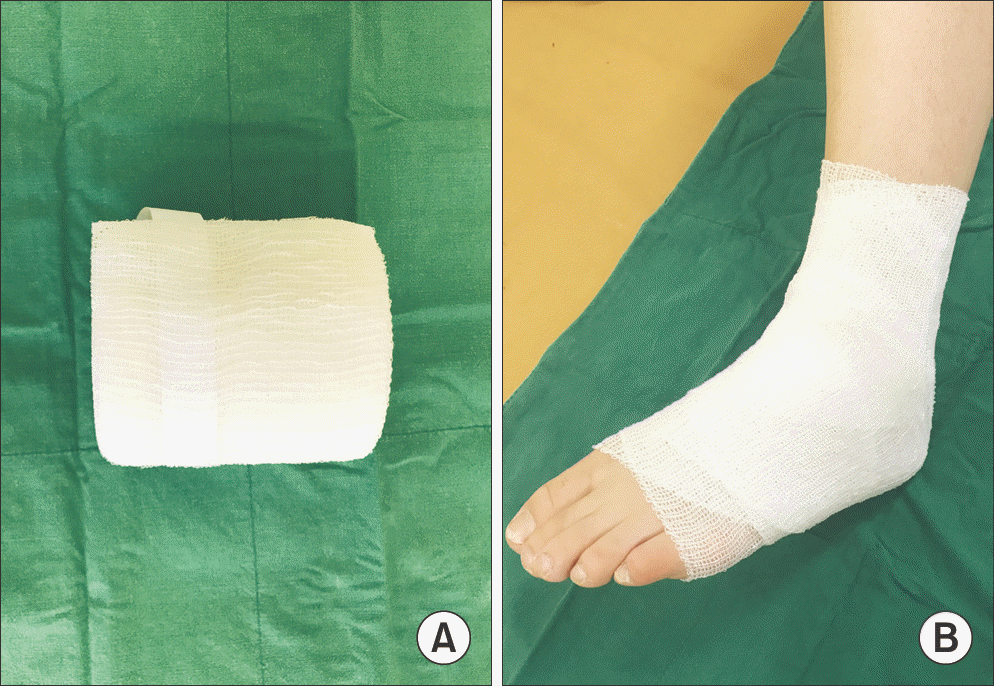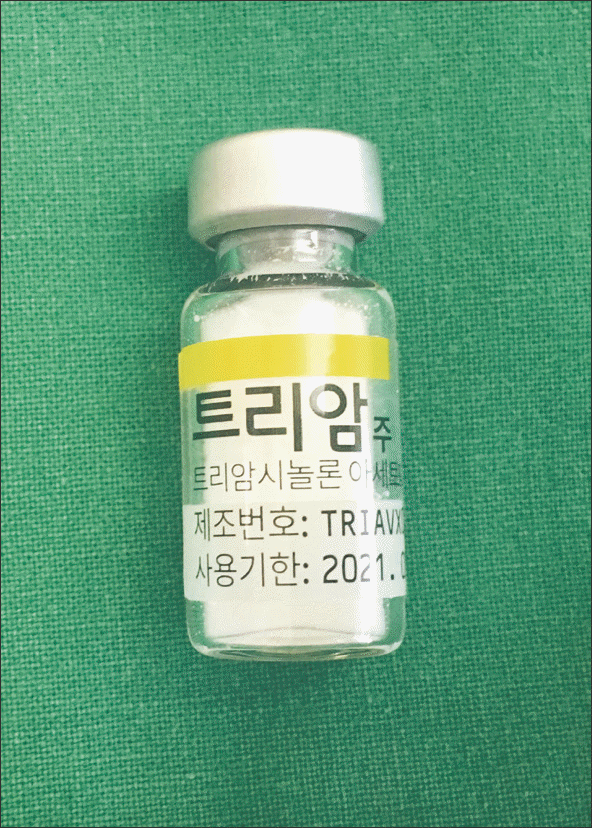Abstract
Purpose:
This study examined the clinical outcomes and usefulness of triamcinolone acetonide (TA) injections as an option in the conservative treatment of patients with lateral malleolar bursitis of the ankle.
Materials and Methods:
A total of 27 patients (27 ankles), in whom TA injection had been performed between March 2016 and June 2017, were reviewed retrospectively. After the aspiration of fluid in the lateral malleolar bursal sac, 1 mL (40 mg) of TA was injected into the malleolar bursal sac. After the injection, the ankle was compressed with an elastic cohesive bandage for 2 to 4 weeks. The clinical outcomes and side effects were evaluated at the following time points: 2 weeks, 4 weeks, 3 months, 6 months, and 1 year after TA injection therapy. The responses to treatment were assessed according to the degree of fluctuation, shrinkage of the bursal sac, and soft tissue swelling.
Results:
The mean age was 62.1 years (range, 41∼81 years); there were 19 males and 8 females. Complete resolution was observed in 26 patients (96.3%) after the first or second application of a TA injection, and a partial response was observed in 1 patient (3.7%) after the first TA injection. The physical component scores of Medical Outcomes Study 36-item Short-Form Health Survey improved from 71.1 to 76.0 at the last follow-up (p=0.001). Associated complications were 1 patient (3.7%) with skin atrophy and 3 patients (11.1%) with transient hyperglycemia in diabetes mellitus.
Go to : 
REFERENCES
1.Park KH., Lee J., Choi WJ., Lee JW. OK-432 sclerotherapy for malleolar bursitis of the ankle. Foot Ankle Int. 2013. 34:1389–94.

2.Choi JH., Lee KT., Lee YK., Kim DH., Kim JR., Chung WC, et al. Endoscopic versus open bursectomy of lateral malleolar bursitis. Knee Surg Sports Traumatol Arthrosc. 2012. 20:1205–8.

3.Avci S., Sayli U. Lateral premalleolar bursitis as a result of sitting on the foot. Foot Ankle Int. 2001. 22:64–6.

4.Brown TD., Varney TE., Micheli LJ. Malleolar bursitis in figure skaters. Indications for operative and nonoperative treatment. Am J Sports Med. 2000. 28:109–11.
5.Wittich CM., Ficalora RD., Mason TG., Beckman TJ. Musculoskeletal injection. Mayo Clin Proc. 2009. 84:831–6. quiz 837.

6.Carroll MB., Motley SA., Wohlford S., Ramsey BC. Rilonacept in the treatment of subacromial bursitis: a randomized, non-inferiority, unblinded study versus triamcinolone acetonide. Joint Bone Spine. 2015. 82:446–50.

7.Therasse P., Arbuck SG., Eisenhauer EA., Wanders J., Kaplan RS., Rubinstein L, et al. New guidelines to evaluate the response to treatment in solid tumors. European Organization for Research and Treatment of Cancer, National Cancer Institute of the United States, National Cancer Institute of Canada. J Natl Cancer Inst. 2000. 92:205–16.
9.Boutin FJ., Boutin RD., Boutin FJ Jr. Bursitis. Chapman MW, Madison M, editors. Operative orthopaedics. 2nd ed.Philadelphia: J.B. Lippincott;1993. p. 3419–32.
10.Hernandez PA., Hernandez WA., Hernandez A. Clinical aspects of bursae and tendon sheaths of the foot. J Am Podiatr Med Assoc. 1991. 81:366–72.

11.Battaglia M., Guaraldi F., Gori D., Castiello E., Arvat E., Sudanese A. Efficacy of triamcinolone acetate and methylprednisolone acetonide for intrabursal injection after ultrasound-guided percutaneous treatment in painful shoulder calcific tendonitis: a randomized controlled trial. Acta Radiol. 2017. 58:964–70.

12.Kumar A., Dhir V., Sharma S., Sharma A., Singh S. Efficacy of methylprednisolone acetate versus triamcinolone acetonide intra-articular knee injection in patients with chronic inflammatory arthritis: a 24-week randomized controlled trial. Clin Ther. 2017. 39:150–8.

13.Charalambous CP., Tryfonidis M., Sadiq S., Hirst P., Paul A. Septic arthritis following intra-articular steroid injection of the knee--a survey of current practice regarding antiseptic technique used during intra-articular steroid injection of the knee. Clin Rheu-matol. 2003. 22:386–90.
14.Black DM., Filak AT. Hyperglycemia with non-insulin-dependent diabetes following intraarticular steroid injection. J Fam Pract. 1989. 28:462–3.
15.Nichols AW. Complications associated with the use of corticosteroids in the treatment of athletic injuries. Clin J Sport Med. 2005. 15:370–5.

16.Pfenninger JL. Injections of joints and soft tissue: part II. Guidelines for specific joints. Am Fam Physician. 1991. 44:1690–701.
17.Degreef I., De Smet L. Complications following resection of the olecranon bursa. Acta Orthop Belg. 2006. 72:400–3.
Go to : 
 | Figure 2.(A) Aspiration of left ankle lateral malleolar bursitis with 21-gauge needle of 20 mL synringe. (B) Injection of 1 mL triamcinolone acetonide through the same needle used for aspiration. |
 | Figure 3.(A) 12 cm×20 m size of elastic cohesive bandage. (B) Application of elastic cohesive bandage. |
Table 1.
Demographic Characteristics and Clinical Outcome of the Patients
M: male, F: female, SD: standard deviation, R: right, L: left, -: no comorbidity, DM: diabetes mellitus, CKD: chronic kidney disease, LC: liver cirrhosis, HCV: hepatitis C virus, CR: complete response, PR: partial response, NR: No response, SF-36: Medical Outcomes Study 36-item Short-Form Health Survey, PCS: physical component score, MCS: mental component score, Pre: preinjection, Post: postinjection.
Table 2.
Response Evaluation Criteria for Malleolar Bursitis of the Ankle1)
| Response to treatment | Shrinkage | Fluctuation | Soft tissue swelling |
|---|---|---|---|
| Complete response | Complete | No | None or minimal |
| Partial response | Partial | Yes | Yes |
| No response | No change | Yes | Yes |
Table 3.
Clinical Outcomes of Triancinolone Acetonide Injection for Lateral Malleolar Bursitis
| Response to treatment | No. (%) of patients |
|---|---|
| Complete response | 26 (96.3) |
| Partial response | 1 (3.7) |
| No response | 0 (0.0) |




 PDF
PDF ePub
ePub Citation
Citation Print
Print



 XML Download
XML Download